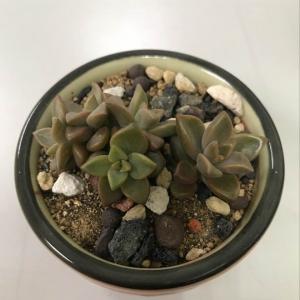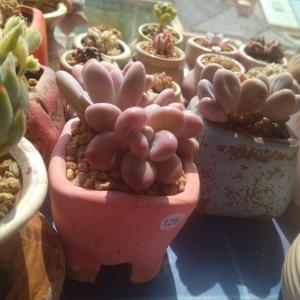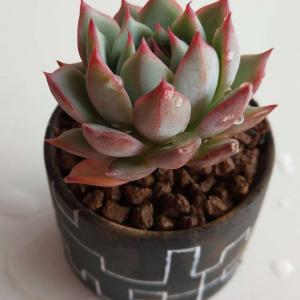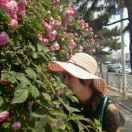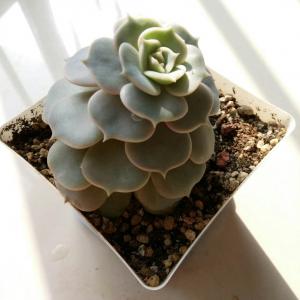文章
Miss Chen
2018年03月27日

Description: This perennial wildflower consists of a rosette of basal leaves, from which a flowering stalk about 1-2' tall is produced. The basal leaves are up to 7" long and 2" across; they are pale green to green, hairless, and oblanceolate or obovate in shape. Their margins are smooth, undulate, slightly dentate, or slightly pinnatifid. The flowering stalk is pale green, hairless, glaucous, terete, and erect. There are 1-2 cauline leaves on the flowering stalk that are ovate in shape and smooth or dentate along their margins. Where the uppermost cauline leaf occurs, the stalk branches into 2-5 ascending peduncles. Each peduncle terminates in a yellow or orange-yellow flowerhead about 1–1½" across. Each flowerhead has many spreading ray florets and no disk florets. Each ray floret is narrowly oblong and yellow or orange-yellow; it has a truncate tip with 5 small teeth. The base of the flowerhead is surrounded by several floral bracts in a single series; each bract is pale green, linear-lanceolate, hairless, glaucous, and about 1/3" (8 mm.) in length or a little longer. The blooming period can occur from late spring to mid-summer and lasts about a month. Later in the year, the ray florets are replaced by small achenes. Each achene is bullet-shaped and truncate at the apex, where it has a tuft of white hairs. The achenes are distributed by the wind. The root system consists of a thickened crown with fibrous roots.

Cultivation: The preference is partial or dappled sunlight and mesic to dry conditions. Different kinds of soil are tolerated, including those containing loam, clay-loam, sand, or rocky material. Water-logged sites should be avoided.
Range & Habitat: The native Two-Flowered Cynthia is occasional to locally common throughout Illinois (see Distribution Map). Habitats include open upland woodlands, open sandy woodlands, savannas and sandy savannas, rocky wooded slopes, thinly wooded bluffs, areas along woodland paths, rocky glades, and upland meadows. Two-Flowered Cynthia is often found in upland habitats where Oaks are dominant in areas with thin leaf cover and sparse ground vegetation.
Faunal Associations: The flowerheads attract long-tongued bees (bumblebees, honeybees, Little Carpenter bees, Cuckoo bees, Mason bees), short-tongued bees (Halictid bees, Masked bees), predatory wasps, flies (Syrphid, Tachinid, & others), butterflies, skippers, and beetles. These insects suck nectar, collect pollen, or feed on pollen from the flowerheads. An oligolectic visitor, Andrena krigiana (Krigia Andrenid Bee), is specifically attracted to the flowerheads of Krigia spp. In addition to these floral visitors, an aphid, Uroleucon brachychaetum, sucks plant juices from these plants. Thus far, I have not observed any evidence that White-Tailed Deer feed on the foliage of Two-Flowered Cynthia, which contains a bitter white latex, although I would not rule out this possibility.
Photographic Location: The photographs were taken along the edge of two wooded bluffs in Vermilion County, Illinois.
Comments: The flowerheads and foliage of this wildflower are quite attractive. Most members of the Aster family with dandelion-like flowerheads (including other Krigia spp. in Illinois) have yellow ray florets, but the ray florets of Two-Flowered Cynthia often have an orange tint. Two-Flowered Cynthia has larger flowerheads (1" across or more), longer floral bracts (1/3" or more), and its achenes have more bristly hairs (20 or more) than either Krigia virginica or Krigia caespitosa (both annuals). Another species, Krigia dandelion (Potato Dandelion) has unbranched flowering stalks that each produce a single flowerhead. In contrast, Two-Flowered Cynthia has flowering stalks that branch above their uppermost cauline leaves, each stalk producing 2-5 flowerheads on separate peduncles.

Cultivation: The preference is partial or dappled sunlight and mesic to dry conditions. Different kinds of soil are tolerated, including those containing loam, clay-loam, sand, or rocky material. Water-logged sites should be avoided.
Range & Habitat: The native Two-Flowered Cynthia is occasional to locally common throughout Illinois (see Distribution Map). Habitats include open upland woodlands, open sandy woodlands, savannas and sandy savannas, rocky wooded slopes, thinly wooded bluffs, areas along woodland paths, rocky glades, and upland meadows. Two-Flowered Cynthia is often found in upland habitats where Oaks are dominant in areas with thin leaf cover and sparse ground vegetation.
Faunal Associations: The flowerheads attract long-tongued bees (bumblebees, honeybees, Little Carpenter bees, Cuckoo bees, Mason bees), short-tongued bees (Halictid bees, Masked bees), predatory wasps, flies (Syrphid, Tachinid, & others), butterflies, skippers, and beetles. These insects suck nectar, collect pollen, or feed on pollen from the flowerheads. An oligolectic visitor, Andrena krigiana (Krigia Andrenid Bee), is specifically attracted to the flowerheads of Krigia spp. In addition to these floral visitors, an aphid, Uroleucon brachychaetum, sucks plant juices from these plants. Thus far, I have not observed any evidence that White-Tailed Deer feed on the foliage of Two-Flowered Cynthia, which contains a bitter white latex, although I would not rule out this possibility.
Photographic Location: The photographs were taken along the edge of two wooded bluffs in Vermilion County, Illinois.
Comments: The flowerheads and foliage of this wildflower are quite attractive. Most members of the Aster family with dandelion-like flowerheads (including other Krigia spp. in Illinois) have yellow ray florets, but the ray florets of Two-Flowered Cynthia often have an orange tint. Two-Flowered Cynthia has larger flowerheads (1" across or more), longer floral bracts (1/3" or more), and its achenes have more bristly hairs (20 or more) than either Krigia virginica or Krigia caespitosa (both annuals). Another species, Krigia dandelion (Potato Dandelion) has unbranched flowering stalks that each produce a single flowerhead. In contrast, Two-Flowered Cynthia has flowering stalks that branch above their uppermost cauline leaves, each stalk producing 2-5 flowerheads on separate peduncles.
0
0
文章
Miss Chen
2018年03月27日

Description: This perennial wildflower is ½–1½' tall, sending up one or more unbranched leafy stems from the root system. These stems are erect, ascending, or sprawling; they are light green, tan, or reddish brown, terete, and canescent. Along each stem, there are densely spaced alternate leaves that appear to be whorled (pointing in all directions). Individual leaves are ¾–1½" long and 1/8" (3 mm.) across; they are linear in shape, smooth along their margins, stiff, and sessile (or nearly so). The upper surfaces of the leaves are medium to dark green and glabrous, while their lower surfaces are pale green and canescent. Each leaf has a prominent midvein.

The central stem terminates in a small cluster of flowerheads (sometimes only a single flowerhead is produced, but there are usually more). Individual flowerheads are born on unbranched peduncles about ½–2" long (rarely, they are longer). Along each peduncle, there are small bracts up to ¼" long that resemble the leaves, except they are much smaller in size. The daisy-like flowerheads span ¾–1¼" across, consisting of 10-20 ray florets and a similar number of disk florets. The petal-like rays are lavender or pale blue-violet, while the tiny corollas of the disk florets are bright yellow, later becoming orange-red. At the base of each flowerhead, there are 4-5 series of appressed floral bracts. Individual floral bracts are scale-like in appearance and linear-oblong in shape; each of these bracts is medium green along the upper one-half of its length, otherwise it is nearly white. The blooming period occurs from early to mid-fall and lasts about 1 month. Both disk and ray florets produce achenes.Stem & Leaves The small achenes are bullet-shaped and pubescent; there is a small tuft of hairs at the apex of each achene. For each tuft, the spreading inner hairs are long, while the outer hairs are short. The tufted achenes are distributed by the wind. The root system forms a caudex with fibrous roots; sometimes, spreading rhizomes are produced, from which vegetative offsets can develop.
Cultivation: The preference is full or partial sun, dry-mesic conditions, and an acidic soil that is sandy or rocky. This wildflower can be cultivated in rock gardens.
Range & Habitat: The native Flax-Leaved Aster is occasional in the northern half of Illinois, while in the southern half of the state it is rare or absent (see Distribution Map). Habitats include upland sand prairies, upland sandy savannas, stabilized sand dunes, open rocky woodlands, rocky wooded slopes, and sandstone glades. This wildflower is found in high quality natural habitats with sparse ground cover. It benefits from occasional wildfires in wooded areas, as this reduces the encroachment of woody vegetation.
Faunal Associations: The nectar and pollen of the flowerheads attract many kinds of insects, including long-tongued bees, short-tongued bees, various flies, butterflies, skippers, and beetles. Several bees are pollinator specialists (oligoleges) of Aster spp. (Asters): Andrena asteris, Andrena asteroides, Andrena hirticincta, Andrena nubecula, Andrena simplex, Andrena solidaginis, and Colletes simulans armata. Some of these bees are also oligoleges of Solidago spp. (Goldenrods). Other insects feed on the leaves, flowers, seeds, plant juices, stalks, or roots of Asters. These species include the plant bug Plagiognathus cuneatus, the leafhopper Macrosteles quadrilineatus, Exema canadensis and other leaf beetles, the long-horned beetle Mecas pergrata, several aphids (mainly Uroleucon spp.), and caterpillars of the butterflies Chlosyne nycteis (Silvery Checkerspot) and Phyciodes tharos (Pearl Crescent). There are also many moth species whose caterpillars feed on Asters (see Moth Table). Among vertebrate animals, the Ruffed Grouse and Wild Turkey eat the leaves and seeds, while the Cottontail Rabbit and White-Tailed Deer browse on the foliage. The White-Footed Mouse and possibly other small rodents also eat the seeds.

Photographic Location: An upland sandy savanna at Hooper Branch Savanna Nature Preserve in Iroquois County, Illinois.
Comments: This wildflower has an elegant appearance. What distinguishes Flax-Leaved Aster from species in the Aster genus are the tufted hairs of its achenes: they consist of a combination of long and short hairs, rather than hairs of uniform length. Nonetheless, it is sometimes referred to as Aster linariifolius because of its similarity to these species in other respects. Flax-Leaved Aster superficially resembles Aster oblongifolius (Aromatic Aster) to some extent, but it has unbranched stems, while the latter species has abundantly branched stems. Because of its short linear leaves, which are arranged in dense pseudo-whorls, Flax-Leaved Aster is relatively easy to identify. Another common name of this species is Stiff-Leaved Aster.

The central stem terminates in a small cluster of flowerheads (sometimes only a single flowerhead is produced, but there are usually more). Individual flowerheads are born on unbranched peduncles about ½–2" long (rarely, they are longer). Along each peduncle, there are small bracts up to ¼" long that resemble the leaves, except they are much smaller in size. The daisy-like flowerheads span ¾–1¼" across, consisting of 10-20 ray florets and a similar number of disk florets. The petal-like rays are lavender or pale blue-violet, while the tiny corollas of the disk florets are bright yellow, later becoming orange-red. At the base of each flowerhead, there are 4-5 series of appressed floral bracts. Individual floral bracts are scale-like in appearance and linear-oblong in shape; each of these bracts is medium green along the upper one-half of its length, otherwise it is nearly white. The blooming period occurs from early to mid-fall and lasts about 1 month. Both disk and ray florets produce achenes.Stem & Leaves The small achenes are bullet-shaped and pubescent; there is a small tuft of hairs at the apex of each achene. For each tuft, the spreading inner hairs are long, while the outer hairs are short. The tufted achenes are distributed by the wind. The root system forms a caudex with fibrous roots; sometimes, spreading rhizomes are produced, from which vegetative offsets can develop.
Cultivation: The preference is full or partial sun, dry-mesic conditions, and an acidic soil that is sandy or rocky. This wildflower can be cultivated in rock gardens.
Range & Habitat: The native Flax-Leaved Aster is occasional in the northern half of Illinois, while in the southern half of the state it is rare or absent (see Distribution Map). Habitats include upland sand prairies, upland sandy savannas, stabilized sand dunes, open rocky woodlands, rocky wooded slopes, and sandstone glades. This wildflower is found in high quality natural habitats with sparse ground cover. It benefits from occasional wildfires in wooded areas, as this reduces the encroachment of woody vegetation.
Faunal Associations: The nectar and pollen of the flowerheads attract many kinds of insects, including long-tongued bees, short-tongued bees, various flies, butterflies, skippers, and beetles. Several bees are pollinator specialists (oligoleges) of Aster spp. (Asters): Andrena asteris, Andrena asteroides, Andrena hirticincta, Andrena nubecula, Andrena simplex, Andrena solidaginis, and Colletes simulans armata. Some of these bees are also oligoleges of Solidago spp. (Goldenrods). Other insects feed on the leaves, flowers, seeds, plant juices, stalks, or roots of Asters. These species include the plant bug Plagiognathus cuneatus, the leafhopper Macrosteles quadrilineatus, Exema canadensis and other leaf beetles, the long-horned beetle Mecas pergrata, several aphids (mainly Uroleucon spp.), and caterpillars of the butterflies Chlosyne nycteis (Silvery Checkerspot) and Phyciodes tharos (Pearl Crescent). There are also many moth species whose caterpillars feed on Asters (see Moth Table). Among vertebrate animals, the Ruffed Grouse and Wild Turkey eat the leaves and seeds, while the Cottontail Rabbit and White-Tailed Deer browse on the foliage. The White-Footed Mouse and possibly other small rodents also eat the seeds.

Photographic Location: An upland sandy savanna at Hooper Branch Savanna Nature Preserve in Iroquois County, Illinois.
Comments: This wildflower has an elegant appearance. What distinguishes Flax-Leaved Aster from species in the Aster genus are the tufted hairs of its achenes: they consist of a combination of long and short hairs, rather than hairs of uniform length. Nonetheless, it is sometimes referred to as Aster linariifolius because of its similarity to these species in other respects. Flax-Leaved Aster superficially resembles Aster oblongifolius (Aromatic Aster) to some extent, but it has unbranched stems, while the latter species has abundantly branched stems. Because of its short linear leaves, which are arranged in dense pseudo-whorls, Flax-Leaved Aster is relatively easy to identify. Another common name of this species is Stiff-Leaved Aster.
0
0
文章
Miss Chen
2018年03月27日

Description: This perennial herbaceous plant is 1-4' tall and unbranched. The central stem is light green to purple, terete, glabrous to short-pubescent below, and short-pubescent above. About 6-30 alternate leaves are distributed evenly along the length of the stem; the leaves remain the same size, or become slightly smaller in size, as they ascend the stem. Individual leaves are 1½–4" long ¼–1¼" across; the length and width of these leaves varies with the robustness of the plant and the local ecotype or variety. Leaf shape is elliptic, lanceolate-elliptic, lanceolate, or lanceolate-ovate, while leaf margins are sparsely dentate, sparsely denticulate (minutely dentate), or smooth. The upper leaf surface is pale-medium to medium green and glabrous, while the lower leaf surface is pale green and glabrous to short-pubescent. Leaf bases are rounded to narrowly wedge-shaped, while their tips are acute. The leaves are either sessile or they clasp the stem; a few leaves may have short petioles (3 mm. or less) that are appressed against the stem.
The central stem terminates in a panicle of flowerheads that is often corymb-like in shape; a large panicle may have more than one corymb-like division. The size of these panicles is 3-20" long and 5-10" across; small panicles are sometimes more wide than they are across, while large panicles are longer in length than they are across. The branches of each panicle are light green, terete, short-pubescent, and largely naked; a few leafy bracts up to ¼" long may be present. The terminal branches produce individual flowerheads about ¾-1¼" across. Each flowerhead has 30-80 ray florets and no disk florets. The petaloid extensions (or rays) of these florets are bright yellow and narrowly oblong in shape; their tips are 5-toothed and truncate. The base of each flowerhead is surrounded by narrow green phyllaries in 2-3 series. The outermost phyllaries are the smallest. These phyllaries are glabrous or short-hairy; sometimes they have short glandular hairs. The blooming period occurs from mid-summer to early fall, lasting about 3-4 weeks for a colony of plants. In the absence of cross-pollination from other plants, the florets are self-fertile. Shortly afterwards, the florets are replaced by small achenes with sessile tufts of light brown hair. The achenes are about 2.5–3 mm. in length, bullet-shaped, ribbed along their sides, and truncate at their apices. They are distributed by the wind. The root system is fibrous, sometimes forming clonal offsets. On older plants, a small caudex may develop.

Cultivation: The preference is full sun to light shade, mesic to dry conditions, and either sandy or rocky soil. This plant dislikes hot summer weather (90°F or higher temperatures). Plant size can vary considerably depending on the habitat, weather, and local ecotype.
Range & Habitat: Northern Hawkweed is occasional in northern Illinois, where it is native (see Distribution Map). It also occurs in Eurasia, although the latter continental mass has varieties that are distinct from those in North America. Habitats include sandy upland savannas, sand prairies, stabilized sand dunes, openings in sandy or rocky woodlands, sandy thickets, sandy fields, and roadsides. Northern Hawkweed can be found in either high quality or disturbed habitats. It probably benefits from occasional wildfires if this reduces competing woody vegetation.
Faunal Associations: Various bees and probably other insects visit the flowerheads for nectar and/or pollen, including Halictid bees. Some aphids suck plant juices from the flowering stems and other parts of hawkweeds (Hieracium spp.); these species include Hyperomyzus inflatus, Nasonovia ribisnigri (Currant-Lettuce Aphid), Uroleucon hieracicola (Hawkweed Aphid), and Uroleucon sonchi (Sow-Thistle Aphid). Another insect, the plant bug Lygus rubroclarus, feeds on hawkweeds and other members of the Aster family. These plants are also suspected hosts of Schinia bina (Bina Flower Moth). Among vertebrate animals, the Ruffed Grouse and Wild Turkey eat the seeds and leaves of hawkweeds to some extent; the Cottontail Rabbit and White-Tailed Deer also browse on the leaves (Martin et al., 1951/1961).

Photographic Location: The wildflower garden of the webmaster in Urbana, Illinois.
Comments: Northern Hawkweed is one of the showier native hawkweeds (Hieracium spp.) because it has larger flowerheads (about 1" across) than most. It also produces more leaves along its stems, and the branches of its inflorescence are short-pubescent, rather than glandular-hairy. The taxonomy of this hawkweed, at least in North America, is somewhat confused. In addition to Hieracium umbellatum (Northern Hawkweed), this plant is also referred to as Hieracium canadense (Canada Hawkweed) and Hieracium kalmii (Kalm's Hawkweed). The view taken here is that Hieracium umbellatum is a highly variable species that subsumes both Eurasian and North American plants. The primary difficulty in North America is that leaf width and the amount of dentition along leaf margins are highly variable. Populations of plants in northeastern United States and southeastern Canada tend to have wider leaves with more strongly defined teeth, while populations of plants in the upper midwest of the United States and south-central Canada tend to have more narrow leaves with poorly defined teeth. In Eurasia, this plant tends to have even more narrow leaves than what is observed in North America. These and other variations have led to the description of different varieties and subspecies that have varied in their popularity across time. Another common name of Hieracium umbellatum is Narrow-Leaved Hawkweed.
The central stem terminates in a panicle of flowerheads that is often corymb-like in shape; a large panicle may have more than one corymb-like division. The size of these panicles is 3-20" long and 5-10" across; small panicles are sometimes more wide than they are across, while large panicles are longer in length than they are across. The branches of each panicle are light green, terete, short-pubescent, and largely naked; a few leafy bracts up to ¼" long may be present. The terminal branches produce individual flowerheads about ¾-1¼" across. Each flowerhead has 30-80 ray florets and no disk florets. The petaloid extensions (or rays) of these florets are bright yellow and narrowly oblong in shape; their tips are 5-toothed and truncate. The base of each flowerhead is surrounded by narrow green phyllaries in 2-3 series. The outermost phyllaries are the smallest. These phyllaries are glabrous or short-hairy; sometimes they have short glandular hairs. The blooming period occurs from mid-summer to early fall, lasting about 3-4 weeks for a colony of plants. In the absence of cross-pollination from other plants, the florets are self-fertile. Shortly afterwards, the florets are replaced by small achenes with sessile tufts of light brown hair. The achenes are about 2.5–3 mm. in length, bullet-shaped, ribbed along their sides, and truncate at their apices. They are distributed by the wind. The root system is fibrous, sometimes forming clonal offsets. On older plants, a small caudex may develop.

Cultivation: The preference is full sun to light shade, mesic to dry conditions, and either sandy or rocky soil. This plant dislikes hot summer weather (90°F or higher temperatures). Plant size can vary considerably depending on the habitat, weather, and local ecotype.
Range & Habitat: Northern Hawkweed is occasional in northern Illinois, where it is native (see Distribution Map). It also occurs in Eurasia, although the latter continental mass has varieties that are distinct from those in North America. Habitats include sandy upland savannas, sand prairies, stabilized sand dunes, openings in sandy or rocky woodlands, sandy thickets, sandy fields, and roadsides. Northern Hawkweed can be found in either high quality or disturbed habitats. It probably benefits from occasional wildfires if this reduces competing woody vegetation.
Faunal Associations: Various bees and probably other insects visit the flowerheads for nectar and/or pollen, including Halictid bees. Some aphids suck plant juices from the flowering stems and other parts of hawkweeds (Hieracium spp.); these species include Hyperomyzus inflatus, Nasonovia ribisnigri (Currant-Lettuce Aphid), Uroleucon hieracicola (Hawkweed Aphid), and Uroleucon sonchi (Sow-Thistle Aphid). Another insect, the plant bug Lygus rubroclarus, feeds on hawkweeds and other members of the Aster family. These plants are also suspected hosts of Schinia bina (Bina Flower Moth). Among vertebrate animals, the Ruffed Grouse and Wild Turkey eat the seeds and leaves of hawkweeds to some extent; the Cottontail Rabbit and White-Tailed Deer also browse on the leaves (Martin et al., 1951/1961).

Photographic Location: The wildflower garden of the webmaster in Urbana, Illinois.
Comments: Northern Hawkweed is one of the showier native hawkweeds (Hieracium spp.) because it has larger flowerheads (about 1" across) than most. It also produces more leaves along its stems, and the branches of its inflorescence are short-pubescent, rather than glandular-hairy. The taxonomy of this hawkweed, at least in North America, is somewhat confused. In addition to Hieracium umbellatum (Northern Hawkweed), this plant is also referred to as Hieracium canadense (Canada Hawkweed) and Hieracium kalmii (Kalm's Hawkweed). The view taken here is that Hieracium umbellatum is a highly variable species that subsumes both Eurasian and North American plants. The primary difficulty in North America is that leaf width and the amount of dentition along leaf margins are highly variable. Populations of plants in northeastern United States and southeastern Canada tend to have wider leaves with more strongly defined teeth, while populations of plants in the upper midwest of the United States and south-central Canada tend to have more narrow leaves with poorly defined teeth. In Eurasia, this plant tends to have even more narrow leaves than what is observed in North America. These and other variations have led to the description of different varieties and subspecies that have varied in their popularity across time. Another common name of Hieracium umbellatum is Narrow-Leaved Hawkweed.
0
0
文章
Miss Chen
2018年03月27日

Description: This perennial wildflower is 1-3½' tall, producing a leafy central stem that is unbranched and more or less erect. The central stem is light green and more or less covered with spreading hairs; some hairs along the upper section of this stem may be glandular, otherwise they are non-glandular. Several alternate leaves occur along the lower three-fourths of this stem, becoming gradually smaller in size and more widely spaced as they ascend toward the inflorescence. The leaf blades are 2-6" long and ½-2" across, lanceolate-oblanceolate to ovate-obovate with smooth to nearly smooth margins. Some larger leaves may have widely spaced dentate teeth that are poorly defined. The upper surface of the leaf blades is medium green and hairy, while the lower surface is pale green and hairy. Each leaf tapers gradually into a petiole-like base and its tip is relatively blunt. Both the central stem and leaves contain a milky latex.

The central stem terminates in an elongated panicle of flowerheads up to 1' long and ½' across. Individual flowerheads are ½-¾" across, consisting of 30-60 yellow ray florets and no disk florets. Around the base of each flowerhead, 12-20 floral bracts (phyllaries) are arranged in a single series. Individual floral bracts are light green, linear in shape, and often glandular-hairy. The branches of the inflorescence are light green to dull purple and glandular-hairy; there are often a small leafy bracts (less than 1" in length) where these branches divide. The glandular hairs along the branches of the inflorescence and the floral bracts of the flowerheads are often black. The blooming period occurs from late summer to early fall for about 3-4 weeks. The florets are self-fertile in the absence of cross-pollination. The florets are replaced by achenes with tufts of tawny hair. Individual mature achenes are about 1/8" (3 mm.) long, narrowly cylindrical in shape, truncate at the apex, and dark brown. The root system is fibrous and rhizomatous; older plants may have a short underground caudex. Small colonies of plants are formed occasionally by the spreading rhizomes. A small rosette of basal leaves may be present during the winter after the flowering stalk with alternate leaves dies down.
Stem & LeavesCultivation: The preference is full sun to light shade, mesic to dry-mesic conditions, and soil containing loam, sand, or rocky material. The size of individual plants and the abundance of their flowerheads is highly variable.
Range & Habitat: The native Rough Hawkweed is occasional in most areas of Illinois (see Distribution Map). Habitats include rocky upland woodlands, bluffs, wooded slopes, woodland openings, savannas and sandy savannas, partially shaded ledges, woodland borders, and sandy roadsides. This wildflower benefits from occasional disturbance to reduce competition from woody vines, shrubs, and trees.
Faunal Associations: Surprisingly little information is available for hawkweeds (Hieracium spp.) about their floral-faunal relationships. The flowerheads are probably cross-pollinated by long-tongued bees and other insects; both nectar and pollen are available as floral rewards to such visitors. Hawkweeds are suspected host plants for the caterpillars of Schinia bina (Bina Flower Moth). The seeds or leaves are occasionally eaten by the Wild Turkey and Ruffed Grouse, while the foliage is browsed sparingly by the Cottontail Rabbit and White-Tailed Deer (Martin et al., 1951/1961). However, the bitter white latex and hairiness of the foliage does not make this species a preferred source of food for such animals.
Photographic Location: A deciduous woodland near an artificial lake at a state park in east-central Illinois.
Comments: This is one of several native hawkweeds (Hieracium spp.) in Illinois that have unbranched leafy stems and yellow flowerheads. Generally, they prefer semi-shaded wooded areas that are sandy or rocky, although Rough Hawkweed also occurs in woodlands with fertile loam. It is very similar in appearance to Hieracium gronovii (Gronovius' Hawkweed), but the latter species has spindle-shaped achenes with tapered upper tips (rather than truncate upper tips), relatively fewer florets per flowerhead (about 20-40), and leaves that are located toward the base of its central stem. Another similar species, Hieracium canadense (Canada Hawkweed), has larger flowerheads (¾-1¼" across) with more florets per flowerhead (40-100), inflorescence branches that are short-pubescent (rather than glandular-hairy), and more leaves along each central stem (often 12 or more). There are some hawkweeds that have been introduced from Europe, but their leaves are arranged in basal rosettes during the blooming period, unlike the native hawkweed species.

The central stem terminates in an elongated panicle of flowerheads up to 1' long and ½' across. Individual flowerheads are ½-¾" across, consisting of 30-60 yellow ray florets and no disk florets. Around the base of each flowerhead, 12-20 floral bracts (phyllaries) are arranged in a single series. Individual floral bracts are light green, linear in shape, and often glandular-hairy. The branches of the inflorescence are light green to dull purple and glandular-hairy; there are often a small leafy bracts (less than 1" in length) where these branches divide. The glandular hairs along the branches of the inflorescence and the floral bracts of the flowerheads are often black. The blooming period occurs from late summer to early fall for about 3-4 weeks. The florets are self-fertile in the absence of cross-pollination. The florets are replaced by achenes with tufts of tawny hair. Individual mature achenes are about 1/8" (3 mm.) long, narrowly cylindrical in shape, truncate at the apex, and dark brown. The root system is fibrous and rhizomatous; older plants may have a short underground caudex. Small colonies of plants are formed occasionally by the spreading rhizomes. A small rosette of basal leaves may be present during the winter after the flowering stalk with alternate leaves dies down.
Stem & LeavesCultivation: The preference is full sun to light shade, mesic to dry-mesic conditions, and soil containing loam, sand, or rocky material. The size of individual plants and the abundance of their flowerheads is highly variable.
Range & Habitat: The native Rough Hawkweed is occasional in most areas of Illinois (see Distribution Map). Habitats include rocky upland woodlands, bluffs, wooded slopes, woodland openings, savannas and sandy savannas, partially shaded ledges, woodland borders, and sandy roadsides. This wildflower benefits from occasional disturbance to reduce competition from woody vines, shrubs, and trees.
Faunal Associations: Surprisingly little information is available for hawkweeds (Hieracium spp.) about their floral-faunal relationships. The flowerheads are probably cross-pollinated by long-tongued bees and other insects; both nectar and pollen are available as floral rewards to such visitors. Hawkweeds are suspected host plants for the caterpillars of Schinia bina (Bina Flower Moth). The seeds or leaves are occasionally eaten by the Wild Turkey and Ruffed Grouse, while the foliage is browsed sparingly by the Cottontail Rabbit and White-Tailed Deer (Martin et al., 1951/1961). However, the bitter white latex and hairiness of the foliage does not make this species a preferred source of food for such animals.
Photographic Location: A deciduous woodland near an artificial lake at a state park in east-central Illinois.
Comments: This is one of several native hawkweeds (Hieracium spp.) in Illinois that have unbranched leafy stems and yellow flowerheads. Generally, they prefer semi-shaded wooded areas that are sandy or rocky, although Rough Hawkweed also occurs in woodlands with fertile loam. It is very similar in appearance to Hieracium gronovii (Gronovius' Hawkweed), but the latter species has spindle-shaped achenes with tapered upper tips (rather than truncate upper tips), relatively fewer florets per flowerhead (about 20-40), and leaves that are located toward the base of its central stem. Another similar species, Hieracium canadense (Canada Hawkweed), has larger flowerheads (¾-1¼" across) with more florets per flowerhead (40-100), inflorescence branches that are short-pubescent (rather than glandular-hairy), and more leaves along each central stem (often 12 or more). There are some hawkweeds that have been introduced from Europe, but their leaves are arranged in basal rosettes during the blooming period, unlike the native hawkweed species.
0
0
文章
Miss Chen
2018年03月26日

Description: This herbaceous perennial plant is 1½–2½' tall, branching occasionally. The round stems are light green and covered with coarse spreading hairs. Both basal and cauline leaves are produced; the cauline leaves are alternate, becoming smaller as they ascend the stems. The basal and lower cauline leaves are oddly pinnate (often with 5 leaflets), while the upperFlower, Stems, & Leaves cauline leaves are trifoliate or simple. The simple leaves and leaflets of the compound leaves are up to 3" long and 2½" across. They are lanceolate to ovate-oval, coarsely serrated or shallowly cleft along the margins, and largely hairless. Sometimes the leaves and leaflets are deeply cleft into 2 or 3 lobes. The terminal leaflet is larger in size than the lateral leaflets. The basal and lower cauline leaves have stout petioles, while the upper cauline leaves are nearly sessile. At the base of each petiole, there is a pair of leafy stipules that are cleft or dentate; each stipule is up to ½" long. The upper stems individually terminate in 1-3 flowers; sometimes single flowers are produced from the axils of the upper leaves. Each flower develops from a stalk (peduncle) up to 3" long; this stalk is covered with coarse spreading hairs. Each flower is about ½" across, consisting of 5 petals that are white or cream, 5 triangular green sepals, and several stamens surrounding a large cluster of green carpels with elongated styles. The petals are shorter than the sepals. The anthers are usually dull yellow or tan. The receptacle of the flower (underneath the carpels) is hairless or nearly so. The blooming period occurs from late spring to mid-summer and lasts about a month. There is no noticeable floral scent. Each flower is replaced by a spheroid cluster of achenes with elongated styles that are hooked at their tips. This fruiting cluster is about ¾" across; it is initially green, but eventually turns brown. The root system consists of a taproot and rhizomes; vegetative offsets are often formed.
Cultivation: The preference is partial sun, moist to mesic conditions, and soil containing loam or sandy loam. Full sun and light shade are also tolerated.
Range & Habitat: The native Rough Avens occurs occasionally in central and northern Illinois, but it is absent from the southern and southwestern areas of the state (see Distribution Map). Habitats include savannas, thickets, woodland borders, and moist meadows. Sometimes it is found in thickets and prairie remnants along railroads and roadsides.
Faunal Associations: Information about floral-faunal relationships for this species is rather limited. They are probably similar to those of Geum canadense (White Avens). The nectar and pollen of the flowers probably attract small bees, wasps, and flies. Insects that feed on the foliage of Geum spp. (Avens) include the aphids Acyrthosiphon pseudodirhodum, Macrosiphum gei, Macrosiphum pallidum, and Macrosiphum pseudorosae. In addition, larvae of a moth, Tinagma obscurofasciella, mine the leaves. The achenes with hooked styles can cling to the fur of mammals, feathers of birds, and clothing of humans; by this means, they can be distributed across considerable distances.

Photographic Location: Between a thicket and prairie remnant along a railroad in Champaign County, Illinois.
Comments: Rough Avens blooms a little later than Geum vernum (Spring Avens), but a little earlier than Geum canadense (White Avens) and Geum virginianum (Pale Avens). It can be confused with White Avens. However, Rough Avens has petals that are shorter than the sepals and its flowering stalks have coarse spreading hairs. White Avens has petals that are as long or longer than the sepals and its flowering stalks are finely pubescent. Pale Avens also has an appearance that is similar to Rough Avens; it is restricted to southern Illinois. Pale Avens has slightly smaller flowers (about 1/3" across) with cream petals that are much shorter than the sepals. The receptacles of its flowers are bristly-hairy, while the receptacles of Rough Avens are hairless or nearly so.
Cultivation: The preference is partial sun, moist to mesic conditions, and soil containing loam or sandy loam. Full sun and light shade are also tolerated.
Range & Habitat: The native Rough Avens occurs occasionally in central and northern Illinois, but it is absent from the southern and southwestern areas of the state (see Distribution Map). Habitats include savannas, thickets, woodland borders, and moist meadows. Sometimes it is found in thickets and prairie remnants along railroads and roadsides.
Faunal Associations: Information about floral-faunal relationships for this species is rather limited. They are probably similar to those of Geum canadense (White Avens). The nectar and pollen of the flowers probably attract small bees, wasps, and flies. Insects that feed on the foliage of Geum spp. (Avens) include the aphids Acyrthosiphon pseudodirhodum, Macrosiphum gei, Macrosiphum pallidum, and Macrosiphum pseudorosae. In addition, larvae of a moth, Tinagma obscurofasciella, mine the leaves. The achenes with hooked styles can cling to the fur of mammals, feathers of birds, and clothing of humans; by this means, they can be distributed across considerable distances.

Photographic Location: Between a thicket and prairie remnant along a railroad in Champaign County, Illinois.
Comments: Rough Avens blooms a little later than Geum vernum (Spring Avens), but a little earlier than Geum canadense (White Avens) and Geum virginianum (Pale Avens). It can be confused with White Avens. However, Rough Avens has petals that are shorter than the sepals and its flowering stalks have coarse spreading hairs. White Avens has petals that are as long or longer than the sepals and its flowering stalks are finely pubescent. Pale Avens also has an appearance that is similar to Rough Avens; it is restricted to southern Illinois. Pale Avens has slightly smaller flowers (about 1/3" across) with cream petals that are much shorter than the sepals. The receptacles of its flowers are bristly-hairy, while the receptacles of Rough Avens are hairless or nearly so.
0
0
文章
Miss Chen
2018年03月26日

Description: This herbaceous perennial plant is about 1½–2½' tall, branching occasionally. The upper stems are light green and pubescent, while the lower stems are often brownish green and coarsely hairy. These stems are round in circumference, rather than angular. There are both basal leaves (produced during the spring) and alternate cauline leaves. The basal leaves are produced in a low rosette up to 6" across. The lower cauline leaves are trifoliate, while the upper cauline leaves are usually simple; they are rather variable in shape. Both simple leaves and leaflets of the compound leaves are up to 4" long and 3" across, becoming smaller as they ascend the stems. They are medium green, lanceolate to oval-ovate, coarsely serrated, and often cleft into 3 major lobes. Their margins are often shallowly cleft or incised as well.
The basal leaves are similar to the cauline leaves, except they are dark green and odd-pinnate with more than 3 leaflets. The wrinkled upper surface of each leaf is either hairless or it has scattered hairs that are very short and bristly; the lower surface is either hairless or it has a few hairs along the major veins. The lower leaves have stout petioles up to 1" long, while the upper leaves have either short petioles or they are sessile. At the base of each petiole, there are a pair of leafy stipules up to ½" long that are usually toothed along their margins. Each upper stem often terminates in an inflorescence of 1-3 flowers; sometimes individual flowers are produced from the axils of the upper leaves. The peduncles are up to 3" long and finely pubescent; they divide into shorter pedicels when there is more than one flower in the inflorescence.

Each flower is about ½" across, consisting of 5 bright white petals, 5 triangular green sepals, and numerous stamens surrounding a cluster of green carpels with elongated styles. The sepals are the same length or shorter than the petals; they are initially spreading, but curve downward with age. The anthers of the stamens are initially white, but they soon turn brown. The receptacle of each flower (the surface underneath the carpels) is pubescent. The blooming period occurs during the summer and lasts about 1-2 months. There is no noticeable floral scent. Each flower is replaced by a spheroid cluster of achenes with persistent styles that are hooked at their tips. This fruiting cluster spans about ¾" across; it is initially green, but eventually turns brown. The root system consists of a taproot and rhizomes; from the latter, vegetative offsets can be produced. This plant occasionally forms loose colonies.

Cultivation: The preference is light shade or partial sun, moist to slightly dry conditions, and a loam or clay-loam soil. At favorable sites, this plant can spread aggressively and is somewhat weedy. White Avens is able to grow underneath Black Walnut trees (Juglans nigra) because of its tolerance to the phytotoxic chemicals that are released by the fallen leaves and roots of this tree.
Range & Habitat: The native White Avens is a common plant that occurs in every county of Illinois (see Distribution Map). Habitats include mesic deciduous woodlands, woodland borders, thickets, partially shaded seeps, fence rows with woody vegetation, powerline clearances in wooded areas, and edges of yards. Sometimes White Avens can be found in disturbed meadows and tall-grass prairies, but this is less typical. It adapts well to disturbed areas.

Faunal Associations: The flowers attract various insects, including bees, wasps, flies, and beetles. These insects suck nectar; some bees also collect pollen, while Syrphid flies often feed on the pollen. Insects that feed on the foliage of White Avens and other Aven species (Geum spp.) consist primarily of aphids, including Acyrthosiphon pseudodirhodum, Amphorophora rossi (White Avens is the preferred host plant), Macrosiphum gei, Macrosiphum pallidum, and Macrosiphon pseudorosae. In addition, the larvae of a moth, Tinagma obscurofasciella, mine the leaves. Apparently the foliage of White Avens is not attractive to mammalian herbivores; it is not often grazed by White-Tailed Deer. The hooked achenes can cling to the fur of mammals, feathers of birds, and clothing of humans; by this means, they are distributed far and wide.
Photographic Location: The photographs were taken near a powerline clearance at Busey Woods in Urbana, Illinois, at a tallgrass prairie of Meadowbrook Park in the same city, and along a woodland border at Chief Shemauger Park in the same city.

Comments: The flowers of White Avens resemble those of various Rubus spp. (Blackberries), except that they are a little smaller. The structure of its flowers is typical of many species in the Rose family. This is probably the most common Geum sp. (Avens) in Illinois. In general, White Avens can be distinguished from other species of Avens by its bright white petals, which are as long or longer than the sepals. Its lower cauline leaves are trifoliate, whereas the lower cauline leaves of other species of Avens are often oddly pinnate with 5 or more leaflets. In particular, Geum laciniatum (Rough Avens) resembles White Avens and occurs in many of the same habitats. However, the petals of its flowers are shorter than the sepals. The flowering stalks of White Avens are finely pubescent, while the flowering stalks of Rough Avens have coarse spreading hairs. Another species, Avens virginianum (Pale Avens), is restricted to southern Illinois. The petals of its flowers are cream rather than bright white, and they are substantially shorter than the sepals. Unlike White Avens, its lower cauline leaves are often odd-pinnate with 5 leaflets.
The basal leaves are similar to the cauline leaves, except they are dark green and odd-pinnate with more than 3 leaflets. The wrinkled upper surface of each leaf is either hairless or it has scattered hairs that are very short and bristly; the lower surface is either hairless or it has a few hairs along the major veins. The lower leaves have stout petioles up to 1" long, while the upper leaves have either short petioles or they are sessile. At the base of each petiole, there are a pair of leafy stipules up to ½" long that are usually toothed along their margins. Each upper stem often terminates in an inflorescence of 1-3 flowers; sometimes individual flowers are produced from the axils of the upper leaves. The peduncles are up to 3" long and finely pubescent; they divide into shorter pedicels when there is more than one flower in the inflorescence.

Each flower is about ½" across, consisting of 5 bright white petals, 5 triangular green sepals, and numerous stamens surrounding a cluster of green carpels with elongated styles. The sepals are the same length or shorter than the petals; they are initially spreading, but curve downward with age. The anthers of the stamens are initially white, but they soon turn brown. The receptacle of each flower (the surface underneath the carpels) is pubescent. The blooming period occurs during the summer and lasts about 1-2 months. There is no noticeable floral scent. Each flower is replaced by a spheroid cluster of achenes with persistent styles that are hooked at their tips. This fruiting cluster spans about ¾" across; it is initially green, but eventually turns brown. The root system consists of a taproot and rhizomes; from the latter, vegetative offsets can be produced. This plant occasionally forms loose colonies.

Cultivation: The preference is light shade or partial sun, moist to slightly dry conditions, and a loam or clay-loam soil. At favorable sites, this plant can spread aggressively and is somewhat weedy. White Avens is able to grow underneath Black Walnut trees (Juglans nigra) because of its tolerance to the phytotoxic chemicals that are released by the fallen leaves and roots of this tree.
Range & Habitat: The native White Avens is a common plant that occurs in every county of Illinois (see Distribution Map). Habitats include mesic deciduous woodlands, woodland borders, thickets, partially shaded seeps, fence rows with woody vegetation, powerline clearances in wooded areas, and edges of yards. Sometimes White Avens can be found in disturbed meadows and tall-grass prairies, but this is less typical. It adapts well to disturbed areas.

Faunal Associations: The flowers attract various insects, including bees, wasps, flies, and beetles. These insects suck nectar; some bees also collect pollen, while Syrphid flies often feed on the pollen. Insects that feed on the foliage of White Avens and other Aven species (Geum spp.) consist primarily of aphids, including Acyrthosiphon pseudodirhodum, Amphorophora rossi (White Avens is the preferred host plant), Macrosiphum gei, Macrosiphum pallidum, and Macrosiphon pseudorosae. In addition, the larvae of a moth, Tinagma obscurofasciella, mine the leaves. Apparently the foliage of White Avens is not attractive to mammalian herbivores; it is not often grazed by White-Tailed Deer. The hooked achenes can cling to the fur of mammals, feathers of birds, and clothing of humans; by this means, they are distributed far and wide.
Photographic Location: The photographs were taken near a powerline clearance at Busey Woods in Urbana, Illinois, at a tallgrass prairie of Meadowbrook Park in the same city, and along a woodland border at Chief Shemauger Park in the same city.

Comments: The flowers of White Avens resemble those of various Rubus spp. (Blackberries), except that they are a little smaller. The structure of its flowers is typical of many species in the Rose family. This is probably the most common Geum sp. (Avens) in Illinois. In general, White Avens can be distinguished from other species of Avens by its bright white petals, which are as long or longer than the sepals. Its lower cauline leaves are trifoliate, whereas the lower cauline leaves of other species of Avens are often oddly pinnate with 5 or more leaflets. In particular, Geum laciniatum (Rough Avens) resembles White Avens and occurs in many of the same habitats. However, the petals of its flowers are shorter than the sepals. The flowering stalks of White Avens are finely pubescent, while the flowering stalks of Rough Avens have coarse spreading hairs. Another species, Avens virginianum (Pale Avens), is restricted to southern Illinois. The petals of its flowers are cream rather than bright white, and they are substantially shorter than the sepals. Unlike White Avens, its lower cauline leaves are often odd-pinnate with 5 leaflets.
0
0









